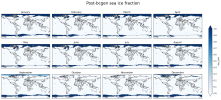I am trying to use B-compset output to generate SST and ICE input for an F-case. I believe I need to use bcgen to convert the B-compset output to mid-month values expected as input for the F-compset.
However, sea ice fraction seems too high and too extensive after running bcgen.
I am using python to re-grid the POP output and correct SST and ice according to Hurrell 2008 prior to running bcgen. The pre-bcgen climatology attached below shows ice fraction after performing the re-gridding and Hurrell 2008 corrections.
I have attached the pre- and post-bcgen climatologies which illustrate the overly extensive sea ice after running ./bcgen.
Does bcgen typically have such a dramatic impact on sea ice extent? Does anyone have advice for addressing this issue?
Thank you,
Andrew
However, sea ice fraction seems too high and too extensive after running bcgen.
I am using python to re-grid the POP output and correct SST and ice according to Hurrell 2008 prior to running bcgen. The pre-bcgen climatology attached below shows ice fraction after performing the re-gridding and Hurrell 2008 corrections.
I have attached the pre- and post-bcgen climatologies which illustrate the overly extensive sea ice after running ./bcgen.
Does bcgen typically have such a dramatic impact on sea ice extent? Does anyone have advice for addressing this issue?
Thank you,
Andrew


